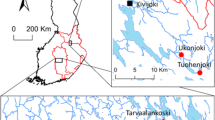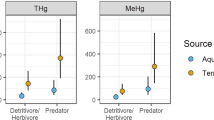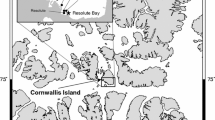Abstract
Mercury (Hg) is a global pollutant that affects biota in remote settings due to atmospheric deposition of inorganic Hg, and its conversion to methylmercury (MeHg), the bioaccumulating and toxic form. Characterizing biotic MeHg is important for evaluating aquatic ecosystem responses to changes in Hg inputs. Aquatic insects possess many qualities desired for MeHg biomonitoring, but are not widely used, largely because of limited information regarding percentages of total mercury (THg) composed of MeHg (i.e., MeHg%) in various taxa. Here, we examine taxonomic, spatial, and seasonal variation in MeHg% of stream-dwelling predator and primary-consumer insects from nine streams in the Adirondack region (NY, USA). Predator MeHg% was high (median 94%) and did not differ significantly among five taxa. MeHg% in selected dragonflies (the most abundant predators, Odonata: Aeshnidae and Libellulidae) exhibited little seasonal and spatial variation, and THg concentration was strongly correlated with aqueous (filtered) MeHg (FMeHg; rs = 0.76). In contrast, MeHg% in primary consumers—shredders (northern caddisflies [Trichoptera: Limnephilidae]) and scrapers (flathead mayflies [Ephemeroptera: Heptageniidae]), were lower (medians 52% and 35%, respectively), and differed significantly between taxa, among sites, and seasonally. Correlations of THg with FMeHg were weak (shredders, rs = 0.45, p = 0.09) or not significant (scrapers, p = 0.89). The higher MeHg% of predators corresponded with their higher trophic positions (indicated by nitrogen stable isotopes). Results suggest obligate predators hold the most promise for the use of THg as a surrogate for MeHg biomonitoring with aquatic insects within the Adirondack region.









Similar content being viewed by others
References
Anderson C, Cabana G (2007) Estimating the trophic position of aquatic consumers in riverine food webs using nitrogen stable isotopes. J North Am Benthol Soc 26:273–285
Baker JP, Van Sickle J, Gagen CJ, DeWalle DR, Sharpe WE, Carline RF, Baldigo BP, Murdoch PS, Bath DW, Kretser WA, Simonin HA, Wiggington Jr PJ (1996) Episodic acidification of small streams in the northeastern United States: effects on fish populations. Ecol Appl 6:422–437. https://doi.org/10.2307/2269380
Baldigo BP, Roy KM, Driscoll CT (2016) Response of fish assemblages to declining acidic deposition in Adirondack Mountain lakes, 1984–2012. Atmos Environ 146:223–235. https://doi.org/10.1016/j.atmosenv.2016.06.049
Batchelar KL, Kidd KA, Drevnick PE, Munkittrick KR, Burgess NM, Roberts AP, Smith JD (2013) Evidence of impaired health in yellow perch (Perca flavescens) from a biological mercury hotspot in northeastern North America. Environ Toxicol Chem 32:627–637. https://doi.org/10.1002/etc.2099
Beaulieu KM, Button DT, Scudder Eikenberry BC, Riva-Murray K, Chasar LC, Bradley PM, Burns DA (2012) Mercury Bioaccumulation Studies in the National Water-Quality Assessment Program–Biological Data from New York and South Carolina, 2005-2009. Reston (VA): U.S. Geological Survey; 2012. Data Series Report No.: 705. https://doi.org/10.3133/ds705
Beeby A (2001) What do sentinels stand for? Environ Pollut 112:285–298. https://doi.org/10.1016/S0269-7491(00)00038-5
Bloom NS (1992) On the chemical form of mercury in edible fish and marine invertebrate tissue. Can J Fish Aquat Sci 49:1010–1017. https://doi.org/10.1139/f92-113
Bodaly RA, Fudge RJP (1999) Uptake of mercury by fish in an experimental boreal reservoir. Arch Environ Contam Toxicol 37:103–109. https://doi.org/10.1007/s002449900494
Boening DW (2000) Ecological effects, transport, and fate of mercury: a general review. Chemosphere 40:1335–1351
Bradley PM, Burns DA, Harvey JW, Journey CA, Brigham ME, Riva-Murray K (2016) Hydraulic and biochemical gradients limit wetland mercury supply to an Adirondack stream. SOJ Aquat Res 1:1–9
Bradley PM, Burns DA, Riva-Murray K, Brigham ME, Button DT, Chasar LC, Marvin-DiPasquale M, Lowery MA, Journey CA (2011) Spatial and seasonal variability of dissolved methylmercury in two stream basins in the eastern United States. Env Sci Technol 45:2048–2055. https://doi.org/10.1021/es103923j
Bradley PM, Journey CA, Brigham ME, Burns DA, Button DT, Riva-Murray K (2012) Intra- and inter-basin mercury comparisons: importance of basin scale and time-weighted methylmercury estimates. Environ Pollut 172:42–52
Brigham ME, Sandheinrich MB, Gay DA, Maki RP, Krabbenhoft DP, Wiener JG (2014) Lacustrine responses to decreasing wet mercury deposition rates—results from a case study in northern Minnesota. Environ Sci Technol 48:6115–6123. https://doi.org/10.1021/es500301a
Brigham ME, Wentz DA, Aiken GR, Krabbenhoft DP (2009) Mercury cycling in stream ecosystems. 1. Water column chemistry and transport. Environ Sci Technol 43:2720–2725. https://doi.org/10.1021/es802694n
Buckland-Nicks A, Hillier KN, Avery TS, O’Driscoll NJ (2014) Mercury bioaccumulation in dragonflies (Odonata: Anisoptera): examination of life stages and body regions. Environ Toxicol Chem 33:2047–2054. https://doi.org/10.1002/etc.2653
Burns DA, Riva-Murray K (2018) Variation in fish mercury concentrations in streams of the Adirondack region, New York: a simplified screening approach using chemical metrics. Ecol Indic 84:648–661. https://doi.org/10.1016/j.ecolind.2017.09.031
Burns DA, Riva-Murray K, Bradley PM, Aiken GR, Brigham ME (2012) Landscape controls on total and methyl Hg in the upper Hudson River basin, New York, USA. J Geophys Res Biogeosci 117:G01034. https://doi.org/10.1029/2011JG001812
Cauchie H-M (2002) Chitin production by arthropods in the hydrosphere. Hydrobiologia 470:63–96
Clayden MG, Kidd KA, Wyn B, Kirk JL, Muir DCG, O’Driscoll NJ (2013) Mercury biomagnification through food webs is affected by physical and chemical characteristics of lakes. Environ Sci Technol 47(21):12047–12053. https://doi.org/10.1021/es4022975
Clayden MG, Kidd KA, Chetelat J, Hall BD, Garcia E (2014) Environmental, geographic and trophic influences on methylmercury concentrations in macroinvertebrates from lakes and wetlands across Canada. Ecotoxicology 23:273–284. https://doi.org/10.1007/s10646-013-1171-9
Cristol DA, Brasso RL, Condon AM, Fovargue RE, Friedman SLK, Hallinger KK, Monroe AO, White AE (2008) The movement of aquatic mercury through terrestrial food webs. Science 320:335–335. https://doi.org/10.1126/science.1154082
Depew DC, Burgess NM, Campbell LM (2013) Modelling mercury concentrations in prey fish: derivation of a national‐scale common indicator of dietary mercury exposure for piscivorous fish and wildlife. Environ Pollut 176:234–243. https://doi.org/10.1016/j.envpol.2013.01.024
Dittman JA, Driscoll CT (2009) Factors influencing changes in mercury concentrations in lake water and yellow perch (Perca flavescens) in Adirondack lakes. Biogeochemistry 93:179–196. https://doi.org/10.1007/s10533-009-9289-9
Driscoll CT, Blette V, Yan C, Schofield CL, Munson R (1995) The role of dissolved organic carbon in the chemistry and bioavailability of mercury in remote Adirondack lakes. Water Air Soil Pollut 80:499–508. https://doi.org/10.1007/978-94-011-0153-0_54
Driscoll CT, Han Y-J, Chen CY, Evers DC, Lambert KF, Holsen TM, Kamman NC, Munson RK (2007) Mercury contamination in forest and freshwater ecosystems in the northeastern United States. Bioscience 57:17–28. https://doi.org/10.1641/B570106
Driscoll CT, Han Y-J, Schofield CL, Munson R, Holsapple J (1994) The mercury cycle and fish in Adirondack lakes. Env Sci Technol 28:136A–143A. https://doi.org/10.1641/B570106
Eagles-Smith C, Wiener JG, Eckley CS, Willacker JJ, Evers DC, Marvin-DiPasquale M, Obrist D, Fleck JA, Aiken GR, Lepak JM, Jackson AK, Webster JP, Stewart AR, Davis JA, Alpers CN, Ackerman JT (2016) Mercury in western North America: a synthesis of environmental contamination, fluxes, bioaccumulation, and risk to fish and wildlife. Sci Total Environ 568:1213–1226. https://doi.org/10.1016/j.scitotenv.2016.05.094
Evers DC, Han Y-J, Driscoll CT, Kamman NC, Goodale MW, Lambert KF, Holsen TM, Chen CY, Clair TA, Butler T (2007) Biological mercury hotspots in the northeastern United States and southeastern Canada. BioScience 57:29–43. https://doi.org/10.1641/B570107
Gorski PR, Cleckner LB, Jiurley JP, Soerszen ME, Armstrong DE (2003) Factors affecting enhanced mercury bioaccumulation in inland lakes of Isle Royale National Park, USA. Sci Total Environ 304:327–348. https://doi.org/10.1016/S0048-9697(02)00579-X
Grieb TM, Driscoll CT, Gloss SP, Schofield CL, Bowie GL, Porcella DB (1990) Factors affecting mercury accumulation in fish in the upper Michigan peninsula. Environ Toxicol Chem 9:919–930. https://doi.org/10.1002/etc.5620090710
Hammerschmidt CR, Fitzgerald WF (2006) Bioaccumulation and trophic transfer of methylmercury in long Island sound. Arch Environ Contam Toxicol 51:416–424. https://doi.org/10.1007/s00244-005-0265-7
Haro RJ, Bailey SW, Northwick RM, Rolfhus KR, Sandheinrich MB, Wiener JG (2013) Burrowing dragonfly larvae as biosentinels of methylmercury in freshwater food webs. Environ Sci Technol 47:8148–8156. https://doi.org/10.1021/es401027m
Harris RC, Bodaly RA (1998) Temperature, growth, and dietary effects on fish mercury dynamics in two Ontario lakes. Biogeochemistry 40:175–187. https://doi.org/10.1023/A:1005986505407
Jardine TD, Kidd KA, Rasmussen JB (2012) Aquatic and terrestrial organic matter in the diet of stream consumers: implications for mercury bioaccumulation. Ecol Appl 22:843–855. https://doi.org/10.1890/11-0874.1
Jeremiason JD, Reiser TK, Weitz RA, Berndt ME, Aiken GR (2016) Aeshnid dragonfly larvae as bioindicators of methylmercury contamination in aquatic systems impacted by elevated sulfate loading. Ecotoxicology 25:456–468. https://doi.org/10.1007/s10646-015-1603-9
Johnson BM, Lepak JM, Wolff BA (2015) Effects of prey assemblage on mercury bioaccumulation in a piscivorous sport fish. Sci Total Environ 506-507:330–337. https://doi.org/10.1016/j.scitotenv.2014.10.101
Kamman NC, Burgess NM, Driscoll CT, Simonin HA, Goodale W, Linehan J, Estabrook R, Hutcheson M, Major A, Scheuhammer AM, Scruton DA (2005) Mercury in freshwater fish of northeast North America—a geographic perspective based on fish tissue monitoring databases. Ecotoxicology 14:163–180. https://doi.org/10.1007/s10646-004-6267-9
Lasorsa B, Allen-Gil S (1995) The methylmercury to total mercury ratio in selected marine, freshwater, and terrestrial organisms. In: Porcella DB, Huckabee JW, Wheatley B (eds) Mercury as a global pollutant. Springer, Dordrecht, https://doi.org/10.1007/978-94-011-0153-0_97
Lescord GL, Johnston TA, Branfireun BA, Gunn JM (2018) Percentage of methylmercury in the muscle tissue of freshwater fish varies with body size and age and among species. Environ Toxicol Chem 37:2682–2691. https://doi.org/10.1002/etc.4233
Loukmas JJ, Quinn SO, Bloomfield J (2006) Total and methyl mercury in the Neversink Reservoir watershed. Albany NY: New York State Department of Environmental Conservation Report No.:11/21/06
Mason RP, Abbott ML, Bodaly RA, Bullock Jr OR, Driscoll CT, Evers DC, Murray ELS, Swain EB (2005) Monitoring the response to changing mercury deposition. Environ Sci Technol 39:14A–22A. https://doi.org/10.1021/es053155l
Mason RP, Laporte JM, Andres S (2000) Factors controlling the bioaccumulation of mercury, methylmercury, arsenic, selenium, and cadmium by freshwater invertebrates and fish. Arch Environ Contam Toxicol 38:283–297. https://doi.org/10.1007/s002449910038
Mergler D, Anderson HA, Chan LHM, Mahaffey KR, Murray M, Sakamoto M, Stern AH (2007) Methylmercury exposure and health effects in humans: a worldwide concern. Ambio 36:3–11. https://doi.org/10.1579/0044-7447
Merritt RW, Cummins KW (1996) An introduction to the aquatic insects of North America, 3rd ed. Kendall/Hunt Publishing Co, Dubuque, IA
Meyer E (1990) Levels of major body compounds in nymphs of the stream mayfly Epeorus sylvicola (Pict.) (Ephemeroptera: Heptageniidae). Archiv Fur Hydrobiologie 117:497–510
Munthe J, Bodaly RA, Branfireun BA, Driscoll CT, Gilmour CG, Harris R, Horvat M, Lucotte M, Maim O (2007) Recovery of mercury-contaminated fisheries. Ambio 36:33–44. https://doi.org/10.1579/0044-7447
Myers LW, Kondratieff BC, Mihuc TB, Ruiger DE (2011) The mayflies (Ephemeroptera), stoneflies (Plecoptera), and caddisflies (Trichoptera) of the Adirondack Park (New York State). Trans Am Entomol Soc 137:63–140
Nelson SJ, Chen CY, Kahl JS (2019). Dragonfly larvae as biosentinels of Hg bioaccumulation in Northeastern and Adirondack lakes: relationships to abiotic factors. Ecotoxicology https://doi.org/10.1007/s10646-019-02149-4
Nelson SJ, Webber HM, Flanagan Pritz CM (2015) Citizen scientists study mercury in dragonfly larvae: dragonfly larvae provide baseline data to evaluate mercury in parks nationwide. National Park Service Natural Resource Report NPS/NRSS/ARD/NRR—2015/938, Fort Collins, CO
Peckarsky BL, Fraissinet PR, Penton MA, Conklin Jr DJ (1990) Freshwater macroinvertebrates of north-eastern North America. Cornell University Press, Ithaca, NY
Riva-Murray K, Chasar LC, Bradley PM, Burns DA, Brigham ME, Smith MJ, Abrahamsen TA (2011) Spatial patterns of mercury in macroinvertebrates and fishes from streams of two contrasting forested landscapes in the eastern United States. Ecotoxicology 20:1530–1542. https://doi.org/10.1007/s10646-011-0719-9
Riva-Murray K, Bradley PM, Chasar LC, Button DT, Brigham ME, Scudder Eikenberry BC, Lutz MA (2013a) Influence of dietary carbon on mercury bioaccumulation in streams of the Adirondack Mountains of New York and the Coastal Plain of South Carolina, USA. Ecotoxicology 22:60–71. https://doi.org/10.1007/s10646-012-1003-3
Riva-Murray K, Bradley PM, Scudder Eikenberry BC, Knightes CD, Journey CA, Brigham ME, Button DT (2013b) Optimizing stream water mercury sampling for calculation of fish bioaccumulation factors. Environ Sci Technol 47:5904–5912. https://doi.org/10.1021/es303758e
Rolfhus KR, Wiener JG, Haro RJ, Sandheinrich MB, Bailey SW, Seitz BR (2015) Mercury in streams at Grand Portage National Monument (Minnesota, USA): assessment of ecosystem sensitivity and ecological risk. Sci Total Environ 514:192–201. https://doi.org/10.1016/j.scitotenv.2015.01.079
Sandheinrich MB, Wiener JG (2011) Methylmercury in freshwater fish—Recent advances in assessing toxicity of environmentally relevant exposures. In: Beyer WN, Meador JP (eds) Environmental contaminants in biota: interpreting tissue concentrations. 2nd ed.CRC/Taylor and Francis, Boca Raton, FL, pp. 169–190. https://doi.org/10.1201/b10598-6
Scudder Eikenberry BC, Riva-Murray K, Smith MJ, Bradley PM, Button DT, Clark JM, Burns DA, Journey CA (2011) Environmental settings of streams sampled for mercury in New York and South Carolina, 2005–09. Reston (VA): U.S. Geological Survey Open-File Report No.: 2011–1318. https://doi.org/10.3133/ofr20111318
Simonin HA, Colquhoun JR, Paul EA, Symula J, Dean HJ (2005) Have Adirondack stream fish populations changed in response to decreases in sulfate deposition? Trans Am Fish Soc 134:338–345. https://doi.org/10.1577/T03-138.1x.2007.12.032
Simonin HA, Loukmas JJ, Skinner LC, Roy KM (2008) Lake variability: key factors controlling mercury concentrations in New York State fish. Environ Pollut 154:107–115. https://doi.org/10.1016/j.envpol
Speir SL, Chumchal MM, Drenner RW, Cocke WG, Kewis ME, Whitt HJ (2014) Methyl mercury and stable isotopes of nitrogen reveal that a terrestrial spider has a diet of emergent aquatic insects. Environ Toxicol Chem 33:2506–2509. https://doi.org/10.1002/etc.2700
Thera JC, Kidd KA, Bertolo RF, O’Driscoll NJ (2019) Tissue content of thiol-containing amino acids predicts methylmercury in aquatic invertebrates. Sci Tot Environ 688:567–573. https://doi.org/10.1016/j.scitotenv.2019.06.225
Thorp JH, Covich AP (1991) Ecology and Classification of North American Freshwater Invertebrates. Academic Press, San Diego
Tremblay A, Lucotte M (1997) Accumulation of total mercury and methyl mercury in insect larvae of hydroelectric reservoirs. Can J Fish Aquat Sci 54:832–841
Tremblay A, Lucotte M, Meili M, Cloutier L, Pichet P (1996) Total mercury and methylmercury contents of insects from boreal lakes: ecological, spatial, and temporal patterns. Water Qual Res J Can 31:851–873
U.S. EPA (2012) Selected analytical methods for environmental remediation and recovery (SAM). U.S. Environmental Protection Agency Report No.: EPA/600/R-12/555, Washington, D.C.
Wiener JG, Bodaly RA, Brown SS, Lucotte M, Newman MC, Porcella DB, Reash RJ, Swain EB (2007) Monitoring and evaluating trends in methylmercury accumulation in aquatic biota. In: Harris R, Krabbenhoft DP, Mason RF, Murray MW, Reash RJ, Saltman T (eds) Ecosystem responses to mercury contamination: indicators of change. Society of Environmental Toxicology and Chemistry, Pencsacola, pp. 87–122 https://doi.org/10.1201/9780849388897.ch4
Wiener JG, Sandheinrich MB, Bhavsar SP, Bohr JR, Evers DC, Monson BA, Schrank CS (2012) Toxicological significance of mercury in yellow perch in the Laurentian great Lakes region. Environ Pollut 161:350–357. https://doi.org/10.1016/j.envpol.2011.09.025
Yu X, Driscoll CT, Huang J, Holden TM, Blackwell BD (2013) Modeling and mapping of atmospheric mercury deposition in Adirondack Park, New York. PLoS ONE 8:e59322. https://doi.org/10.1371/journal.pone.0059322
Yu X, Driscoll CT, Montesdeoca M, Evers D, Duron M, Williams K, Schoch N, Kamman NC (2011) Spatial patterns of mercury in biota of Adirondack, New York lakes. Ecotoxicology 20:1543–1554. https://doi.org/10.1007/s10646-011-0717-y
Zhang Y, Jacob DJ, Horowitz HM, Chen L, Amos HM, Krabbenhoft DP, Slemr F, Louis VLS, Sunderland EM (2016) Observed decrease in atmospheric mercury explained by global decline in anthropogenic emissions. Proc Natl Acad Sci USA 113:526–531. https://doi.org/10.1073/pnas.1516312113
Acknowledgements
This work was supported by the New York State Energy Research and Development Authority, with cooperative matching funds from the U.S. Geological Survey (USGS). The USGS National Water Quality Assessment Program funded the original collection and laboratory analysis of insect samples. The authors appreciate the advice and insight provided by John De Wild (USGS, Mercury Research Laboratory) and Daniel Button (USGS, Ohio Water Science Center); suggestions on an earlier draft by Barbara Eikenberry (USGS), (Wisconsin Water Science Center) and several anonymous reviewers are greatly appreciated. Any use of trade, firm, or product names is for descriptive purposes only and does not imply endorsement by the US Government.
Funding
This study was funded by New York State Energy Research and Development Authority (NYSERDA) under Agreement #40515.
Author information
Authors and Affiliations
Corresponding author
Ethics declarations
Conflict of interest
The authors declare that they have no conflict of interest.
Ethical approval
All applicable international, national, and/or institutional guidelines for the care and use of animals were followed.
Additional information
Publisher’s note Springer Nature remains neutral with regard to jurisdictional claims in published maps and institutional affiliations.
Supplementary information
Rights and permissions
About this article
Cite this article
Riva-Murray, K., Bradley, P.M. & Brigham, M.E. Methylmercury—total mercury ratios in predator and primary consumer insects from Adirondack streams (New York, USA). Ecotoxicology 29, 1644–1658 (2020). https://doi.org/10.1007/s10646-020-02191-7
Accepted:
Published:
Issue Date:
DOI: https://doi.org/10.1007/s10646-020-02191-7




